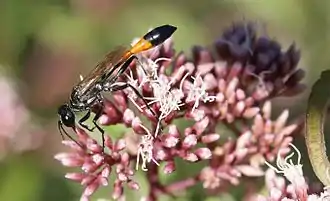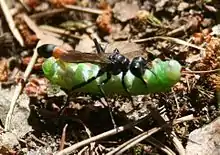Ammophila sabulosa
Ammophila sabulosa, the red-banded sand wasp, is a species of the subfamily Ammophilinae of the hunting wasp family Sphecidae.[2] Found in northern Europe, the wasp is notable for the mass provisioning behaviour of the females, hunting caterpillars mainly on sunny days, paralysing them with a sting, and burying them in a burrow with a single egg. The species is also remarkable for the extent to which females parasitise their own species, either stealing prey from nests of other females to provision their own nests, or in brood parasitism, removing the other female's egg and laying one of her own instead.
| Ammophila sabulosa | |
|---|---|
 | |
| Ammophila sabulosa on a hemp agrimony flower head | |
 | |
| Ammophila sabulosa carrying a caterpillar | |
| Scientific classification | |
| Kingdom: | Animalia |
| Phylum: | Arthropoda |
| Class: | Insecta |
| Order: | Hymenoptera |
| Family: | Sphecidae |
| Genus: | Ammophila |
| Species: | A. sabulosa |
| Binomial name | |
| Ammophila sabulosa | |
| Synonyms [1] | |
|
Sphex sabulosa Linnaeus, 1758 | |
Description
Ammophila sabulosa is a large (15–25 millimetres or 0.59–0.98 inches long) and striking solitary wasp with a very long narrow "waist" of two segments. The species can be told from A. pubescens (which is smaller, 12–20 mm or 0.47–0.79 in long) as the waist widens out very gradually into the "tail" of the abdomen. The pattern of the forewings also differs: the third submarginal cell makes broad contact with the cell to its front and the rear end of the abdomen has a faint metallic blue sheen.[3] The whole body is black except for the front half of the "tail", which is orange.
Behaviour
The adults fly in summer on heathland and sandy places, hunting for caterpillars. The wasp grabs the upper (dorsal) side of each caterpillar, and angles her long abdomen around under the caterpillar to sting it on its lower (ventral) side, paralyzing it.[4] The female digs burrows in sandy ground, provisions each burrow with a food supply of paralyzed caterpillars, and lays one egg, always on the first caterpillar.[5] A female may make up to ten nests, one at a time; about half the nests are provided with one large caterpillar, and half with two to five smaller caterpillars.[5] The burrow is sealed with stones, twigs or pieces of earth and then covered with sand. The female camouflages the nest with debris such as pine needles and pebbles unless the surface in the area is bare sand.[5] Females are normally active only in direct sunlight. Nests are nearly always mass provisioned, which means fully stocked with enough food to take the wasp larva through to pupation, and then permanently closed.[5]
Brood parasitism
Females often parasitize their own species, either stealing prey from nests of other females to provision their own nests, or in brood parasitism, removing the other female's egg and laying one of her own instead.[6] Brood parasitism "appears to be a cheap and easy route to producing offspring", as it takes only about 30 minutes to switch eggs in an existing nest, but about 10 hours to build and provision a new nest; however, more than 80% of brood-parasitized nests were themselves parasitized by another female.[7]
Distribution
Ammophila sabulosa is widely distributed across Eurasia with records from France, the Netherlands, Germany, Austria, Hungary, Poland, Norway, Sweden and Finland, then ranging eastwards as far as the Russian Far East, with a very few records in India and Japan.[8] It is also found in the southern half of Britain.[3]
Former Subspecies
Several subspecies have been described, but none of these are presently considered as conspecific with sabulosa;
- Ammophila vagabunda F. Smith, 1856, (includes Ammophila sabulosa solowiyofkae Matsumura, 1911, a junior synonym)
- Ammophila touareg Ed. André, 1886
References
- Toshko Ljubomirov; Erol Yildirim (2008). Annotated Catalogue of the Ampulicidae, Sphecidae, and Crabronidae (Insecta: Hymenoptera) of Turkey. Pensoft Series Faunistica. 71. Pensoft Publishers. p. 37. ISBN 978-954-642-312-2.
- George W. Peckham; Elizabeth G. Peckham (1905). Wasps, Social and Solitary. Constable.
- Michael Chinery (2004). Collins Complete Guide to British Insects. Collins. p. 338.
- Maurizio Casiraghi; Adriano Martinoli; Tiziana Bosco; Damiano Giovanni Preatoni; Francesco Andrietti (2001). "eNest provisioning and stinging pattern in Ammophila sabulosa (Hymenoptera, Sphecidae): influence of prey size". Italian Journal of Zoology. 68 (4): 299–303. doi:10.1080/11250000109356422.
- Jeremy Field (1989). "Intraspecific parasitism and nesting success in the solitary wasp Ammophila sabulosa" (PDF). Behaviour. 110 (1–4): 23–45. doi:10.1163/156853989X00367. JSTOR 4534782. Archived from the original (PDF) on 2011-04-01.
- Jeremy Early. "Lowland heathland solitary wasps – Ammophila species". Nature Conservation Imaging. Retrieved January 6, 2012.
- Kevin M. O'Neill (2001). Solitary Wasps: Behavior and Natural History. Cornell University Press. p. 129.